5.1 Gas natural vehicular (GNV)
Even though mobility has yet to return to pre-pandemic levels, the use of natural gas as a fuel continued to rise in 2021. There was a 16% rise in stations connected to MRG networks and consumption tripled in comparison with data from 2015.
Over the 2021 financial year, three new NGV supply stations were opened: two of which are public access, in the towns of Fuenlabrada and Leganés, which have close to 200,000 inhabitants with ECO mobility needs for people and goods, and another, in south Madrid, for use by taxi professionals.
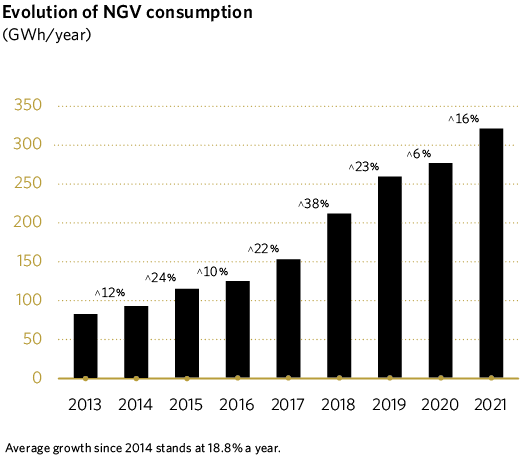
The use of natural gas as
a fuel continued to rise in 2021. There was a 16% rise in stations connected to MRG networks and consumption tripled in comparison with data from 2015
In terms of air quality, the main problems relate to NO2 and particles, which are most prevalent in urban and suburban areas, which is why NGV is the solution to transition to the future of mobility that hydrogen can provide, as the benefits of using NGV are well known: twice as ECO (economic and environmental), saving and reducing emissions (20% of CO2 and almost 100% of NO2 and particles). NGV is also the gateway to the use of renewable gases for mobility, as it is 100% compatible with and replaceable by biomethane obtained from various types of waste, the greatest exponent of circular economics. The decarbonisation of transport is therefore possible not solely through electrification, but also through the use of these gases.
On the other hand, in 2021 a total of 3,177 NGV-powered vehicles were registered in Spain, with a notable increase in truck registrations, where sales of LNG trucks rose by 34% and by 60% for CNG trucks, achieving a market share of 4.1%, proving the interest shown by transport professionals in this fuel. Half of these vehicle registrations were made in the Region of Madrid, where MRG operates, and where there are 113 CNG refuelling stations (23 of which are in the city of Madrid) and 78 LNG stations. Many more of these refuelling points are also currently being planned or built throughout the rest of Spain, where in 2021 15 new CNG and 15 LNG refuelling stations were built, consolidating an infrastructure that makes NGV-powered mobility along the main transport routes a reality throughout mainland Spain, particularly in the country’s larger cities.
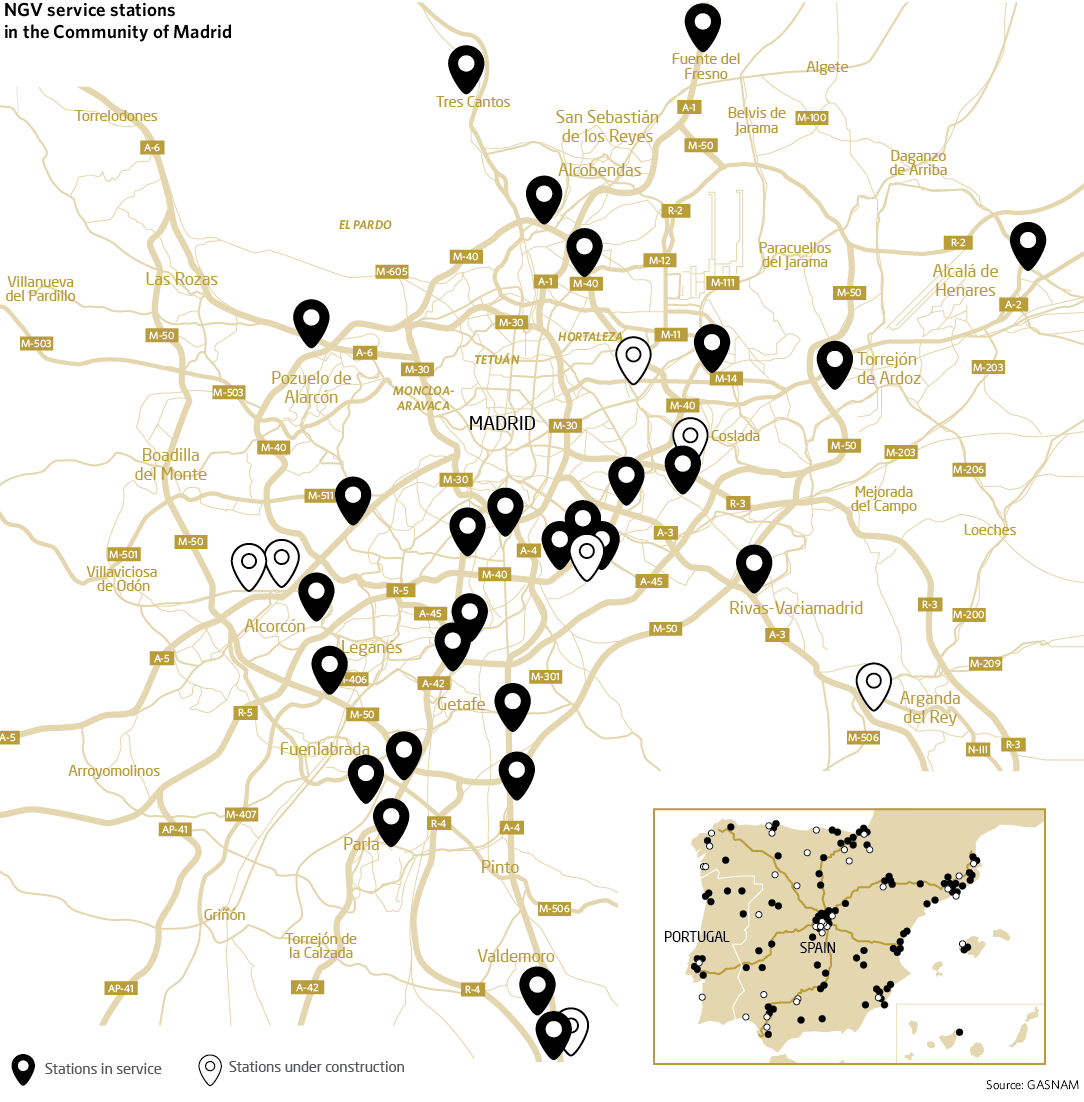

5.2 Environment
With regard to the environment, and in order to estimate fugitive emissions of methane into the distribution network, Madrileña Red de Gas maintains its system of environmental performance indicators. During the past financial year, use of the methodology by events has progressed satisfactorily, the result of which is taken into account for the corresponding carbon footprint report. Thus, the carbon footprint report on scopes 1 and 2 for 2021, which uses the ISO 14064 as its base standard, has been verified by an independent third party: the global testing, inspection and certification company Bureau Veritas. Scope 3 is expected to be included in the next report. The carbon footprint report was also submitted to the Spanish Climate Change Office, which awarded it the “Calcula 2” seal.
Additionally, notification of reports on contaminated land from dismantled LPG plants continued apace and it is expected that the owners of said land will be notified of the conclusions to the administrative rulings issued in relation to this process.
Finally, MRG renewed the certifications for its integrated management system (IMS) on the environment, quality and prevention in accordance with the ISO 14001 and ISO 9001 standard, respectively. The company also obtained ISO 45001 certification, replacing OHSAS 18001. Progress was made with regard to introducing improvements in the digitalisation of personalised IncaWeb processes, and the tool’s various other processes were also strengthened.
The ESG report includes specific chapters that go into further detail about these issues.
5.3 Inspira Madrid project
One of the main causes of polluting emissions in the Region of Madrid is land transport, which accounts for 55% of the region’s CO2 emissions.
Together with the Professional Taxi Federation of the Region of Madrid (FPTM) and the companies FRV, Toyota España and the Ruiz Group, MRG is participating in Inspira Madrid, the most important project on green hydrogen mobility in the Region of Madrid. In collaboration with PWC as strategic advisor, Inspira Madrid promotes the decarbonisation of urban public transport fleets through the use of green hydrogen, contributing to the entire value chain, from the infrastructure to generate and supply the gas through to promoting its use by the transport sector.

Inspira Madrid will actively collaborate with the various green hydrogen off-takers to guarantee demand for the hydrogen produced. These collaborations come with the strategic backing of the FPTM in terms of the sector’s progressive decarbonisation
Inspira Madrid was designed to be modular, flexible and adaptable, so it can be progressively scaled up in subsequent phases of the project’s expansion. The initial phase is eligible for subsidy as it is included in section 2.e – “Implementation of hydrogen distribution plants for fuel-cell vehicles” – (complying with the requirement of hydrogen from renewable sources) of Appendix I of the regulatory terms of the MOVES programme Singular Projects II.
In an initial phase, Inspira Madrid will install a 5 MW polymer-electrolyte membrane (PEM), fed through the direct connection with a solar power plant implemented in the Region of Madrid. This facility is complemented by a connection to the network that will supply power through a PPA (power purchase agreement), and which comes with certificates of origin guaranteeing that its source is renewable. All of the hydrogen produced will be allocated to a network of five public-access hydrogen plants, with an individual daily supply capacity of 200-300 kg of green hydrogen. Unlike with conventional fossil fuels, these hydrogen plants will supply light and heavy-duty vehicles at a competitive price. In this phase, the off-taker, or wholesale end user will be the fleet of taxis operating in the Region of Madrid; an estimated 650 vehicles are expected to be transformed. The Ruiz Group is expected to transform five buses to run on fuel cells.
In the next phase, the hydrogen-generating infrastructure will begin to be scaled up. The design of this phase means that the PEM can be scaled up to 10 MW, and the network is expected to be scaled up to between eight and ten hydrogen plants, with an increased supply capacity (from 300 to 600 kg). A thousand vehicles from the taxi sector fleet and 20 buses are expected to be transformed in this phase.

Throughout the project’s various phases, Inspira Madrid will actively collaborate with the various green hydrogen off-takers to guarantee demand for the hydrogen produced. These collaborations come with the strategic backing of the FPTM in terms of the sector’s progressive decarbonisation. In this context, work is ongoing with Toyota España to develop an innovative business model to implement a new hydrogen fuel-cell vehicle in the taxi sector.
Inspira Madrid will actively collaborate with the various green hydrogen off-takers to guarantee demand for the hydrogen produced. These collaborations come with the strategic backing of the FPTM in terms of the sector’s progressive decarbonisation
The project also includes a commitment from the Ruiz Group, which specialises in urban bus transport, support from the Seur Group, a leading Spanish logistics company that has undertaken an ambitious process of decarbonising its fleet, and involvement from the municipal waste collection company Getafe LYMA and the cash-in-transit company LOOMIS.
The project has representation of all of the region’s main forms of transport, of both people and goods alike. In terms of MRG, the company will use Inspira Madrid to bring about a progressive transformation of its fleet of vehicles powered by renewable hydrogen.
5.4 Henares Corridor – Green H2 project
In the framework of the Region of Madrid policy to move towards a model of sustainable transport and mobility, it is essential to foster specific courses of action aimed at reducing the effects of greenhouse gases and pollutants, and to reduce overall energy consumption. This is why renewable hydrogen will be a fundamental aspect of the region’s sustainability policy.
Madrid also has the Air Quality and Climate Change Strategy (Planazul + 2013-2020), aimed at achieving a 10% reduction in recorded CO2 emissions in 2020 compared with 2005, and 30,000 fewer tonnes of substances released into the atmosphere.
Because the transport and mobility sector is one of the highest consumers of energy, and responsible for a significant percentage of atmospheric emissions, the use of renewable hydrogen is essential for this sector when it comes to reach the decarbonisation targets set. For the industrial sector, the Spanish road map has set the target of replacing 25% of grey hydrogen by 2030.
The Henares Corridor – Green H2 project is therefore a unique opportunity to foster the use of renewable hydrogen, contributing to the decarbonisation process in the Region of Madrid by helping to modify the activities that result in the heaviest emissions, namely transport and industry.
The Henares Corridor – Green H2 project is a unique opportunity to foster the use of renewable hydrogen and help the Region of Madrid to decarbonise through its effects on transport and industry
The Henares Corridor is a strategic part of Madrid’s economy. Located to the east of the metropolitan area, this is a residential, industrial and business area made up of 16 municipalities with a combined population of more than half a million inhabitants (around 8.4% of the region’s population), and is a dynamic part of a first-rate industrial enclave.
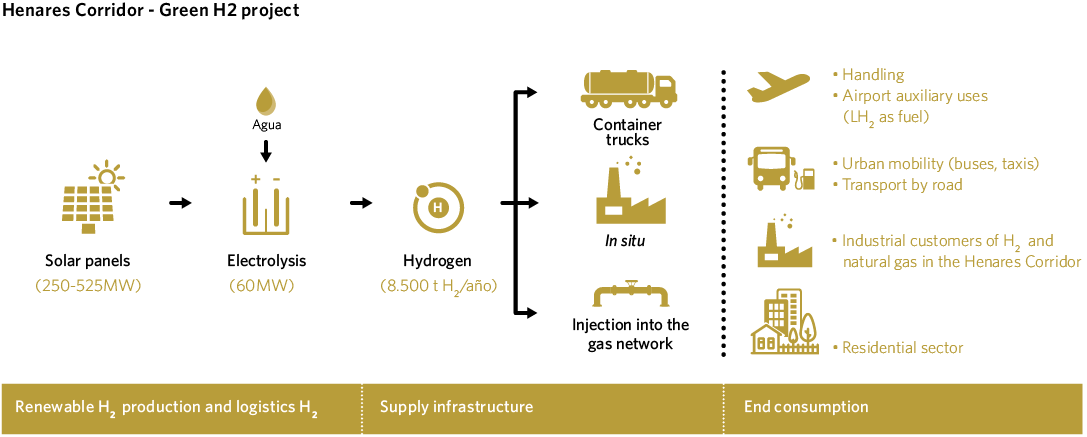
The Henares Corridor is where a significant part of the Madrid region’s productivity is based. It is where 7.1% of the region’s industrial facilities are located and where 6.9% of the region’s population is employed, and is therefore an ideal in which to develop economic activities, particularly those with links to transport and logistics. Its location along the Madrid-Zaragoza-Barcelona axis means it is on the route for goods coming in from elsewhere in Europe. This axis is the most important logistical enclave in the Iberian Peninsula, as it includes the Adolfo Suárez Madrid-Barajas airport, one of the most important infrastructures and transport hubs in the region, as the largest Spanish airport in terms of passengers, air cargo and number of operations.
Madrileña Red de Gas forms part of the consortium made up of ENAGAS Renovables, EDF and Q-Energy, with the aim of making a pioneering contribution to deploying green hydrogen production capacity by combining solar and wind power produced where the project itself is based.
The hydrogen produced will be used mainly to decarbonise the Adolfo Suárez Madrid-Barajas airport by replacing natural gas with green hydrogen from the existing cogeneration plant, helping to meet the airport’s energy needs. It will also be used for fuel cells to power the machinery used in the airports and loading terminals for goods and passenger handling, replacing their current consumption with power from renewable hydrogen. Part of the energy produced will also be used to support pre-industrialisation processes of aircraft prototypes powered by renewable hydrogen.
To that end, a series of 60 MW proton exchange membranes (PEMs) will be used, divided into respective 25 MW and 35 MW phases. The hydrogen plant will also have a compressor to increase the pressure, so that the hydrogen can be stored and transported by truck to the various consumption points close to the project’s location.
Several hydrogen distribution points will also be installed in the Henares Corridor area, which will be used to supply the energy needs for hydrogen-powered mobility, mainly in relation to urban transport and for medium and long distance heavy goods transport.
Furthermore, the project’s benefits will make Madrid an innovation leader in the use of green H2 for mobility (urban transport, rail and air transport), smart networks, and in systems used for guarantees of origin and green certification. It will also enable various place of learning, such as the University of Alcalá de Henares, the Carlos III University and technology centres to share knowledge and train future engineers and operators of Spain’s new renewable H2 industry.
The Henares Corridor – Green H2 project will make Madrid an innovation leader in the use of green H2 for mobility and smart networks, and in systems used for guarantees of origin and green certification.
The project will also boost job creation: more than a thousand new jobs are expected to be generated in the development and construction stage, and close to a hundred in the operating stage. These estimates are based on the project’s full completion and the complete value chain, both the solar power plant and the H2 value chain, which will reduce CO2 emissions by 132,000 tonnes/year, helping to improve air quality and people’s health.
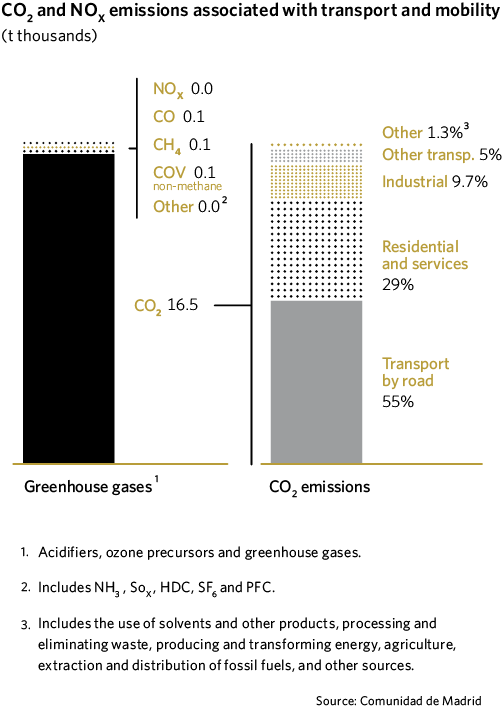
5.5 Ready4H2 project
The importance of the role that hydrogen currently plays in decarbonising the power grid is based on the fact that climate change has forced the industry to place limitations on greenhouse gas emissions. Hydrogen is therefore a key element in Europe’s energy transition, and gas distribution companies are an important part of ensuring a rapid rollout. For decades, European gas distributors have shown their capacity to provide a network of safe and profitable gas pipelines, as well as having plenty of experience in how they should be managed, which can help to ensure a speedy and agile transformation of Europe’s energy infrastructure.
The Ready4H2 project is aimed at combining the hydrogen expertise and experience of European gas distribution companies, helping to produce a common framework of collaboration to analyse how distribution networks can help to make the huge potential for growth of this gas a reality, as well as providing a regulatory framework for it to be developed that harnesses the potential of Europe’s existing gas infrastructure, and therefore help to achieve climate neutrality targets by reducing the impact of Europe’s carbon footprint for people’s benefit.
To that end, more than 90 gas distributors from 17 EU countries are collaborating on Ready4H2. Madrileña Red de Gas is one of the five Spanish gas companies (along with Nedgia, Redexis, Nortegas and Gas Extremadura) that have joined the initiative to share their experiences of different markets and shape the role of gas distribution networks throughout the hydrogen value chain as the necessary link between producers and consumers. Combined with the other European distributors, this will create an ideal scenario to ensure the project is properly implemented and able to prosper.
In Europe, more than a million kilometres of gas pipelines, 96% of the total, have been prepared to distribute hydrogen
Work on the Ready4H2 project is focused on three fronts. The first of these is the analysis of the various distributors’ involvement in developing hydrogen, the accumulated experience and the strategy adopted in different countries. This also includes examining how the different official bodies are involved in developing hydrogen and up to what point the hydrogen strategy has evolved in each country.
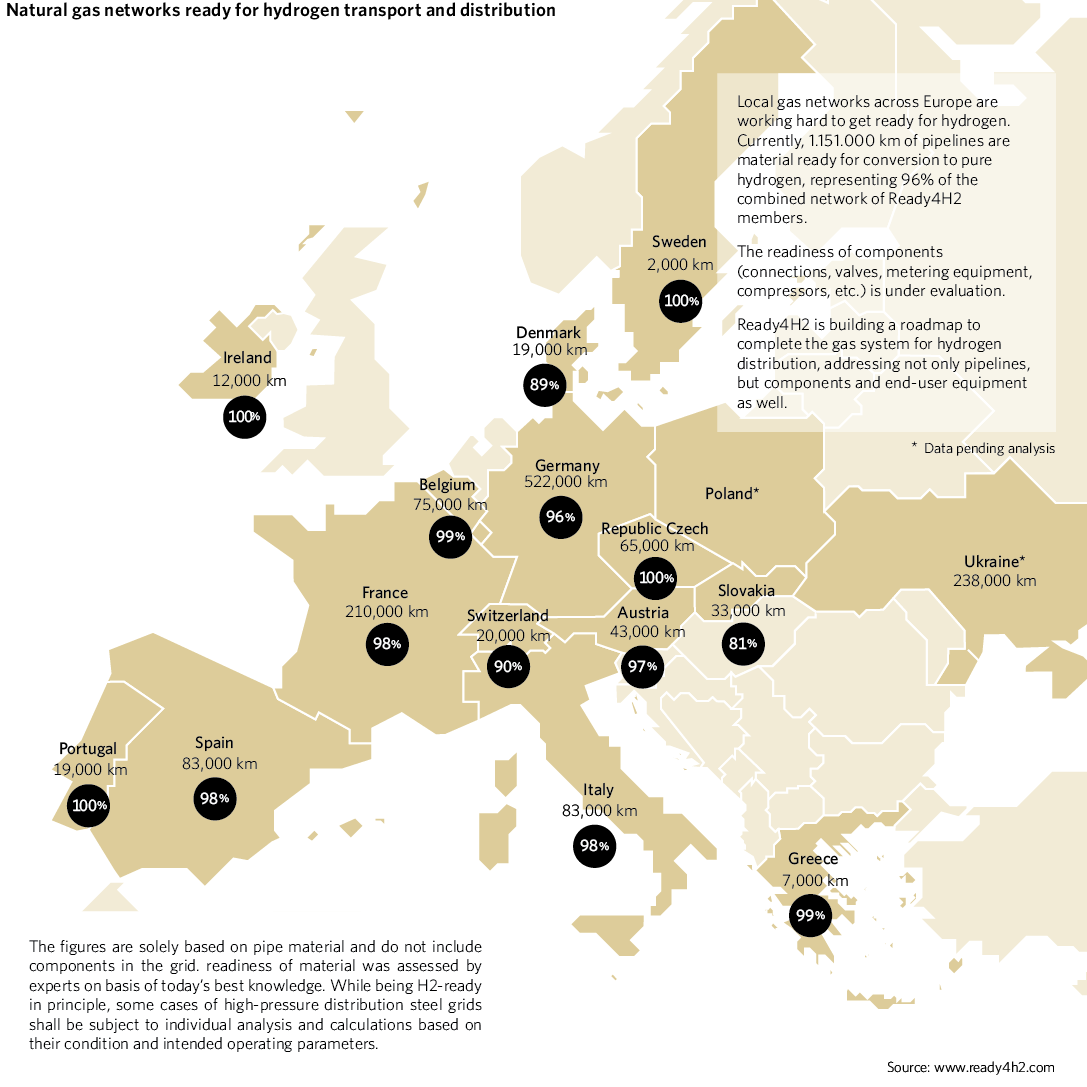
The second front is concerned with how European gas distributors can contribute to the development of hydrogen and the strategic planning for the region, analysing each distributor’s experiences and knowledge, as well as the position of gas distribution companies and their contribution to strategic planning for the region.
The third front consists of drawing up a road map with specific initiatives so that gas distributors can form the link, at both the national and the European level, between hydrogen producers and consumers.
